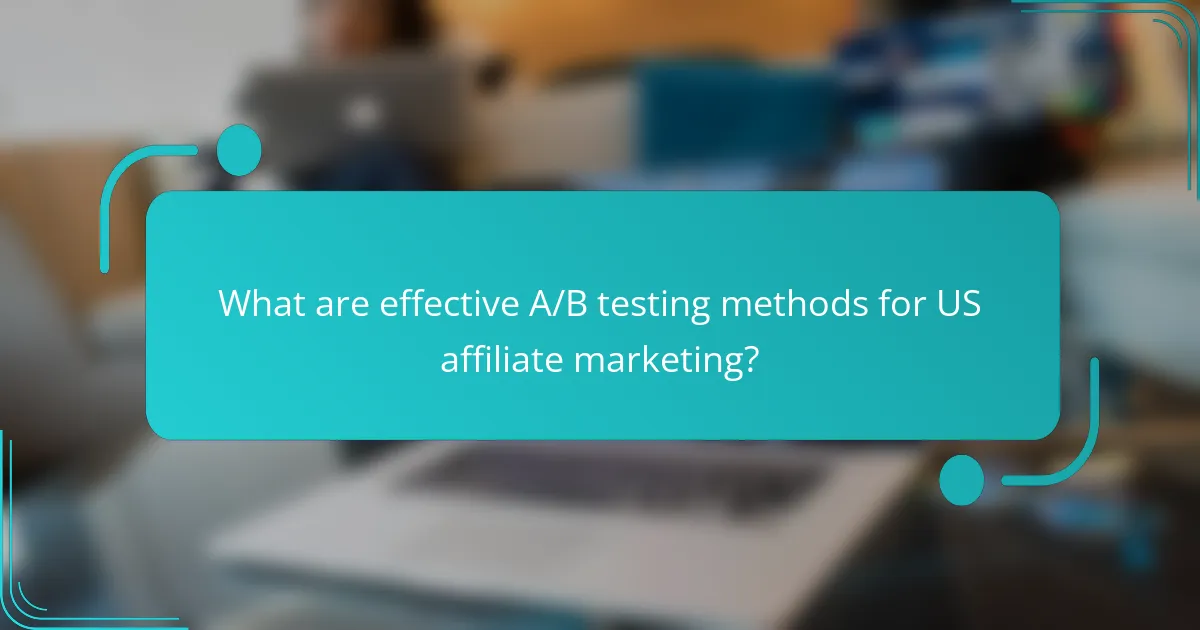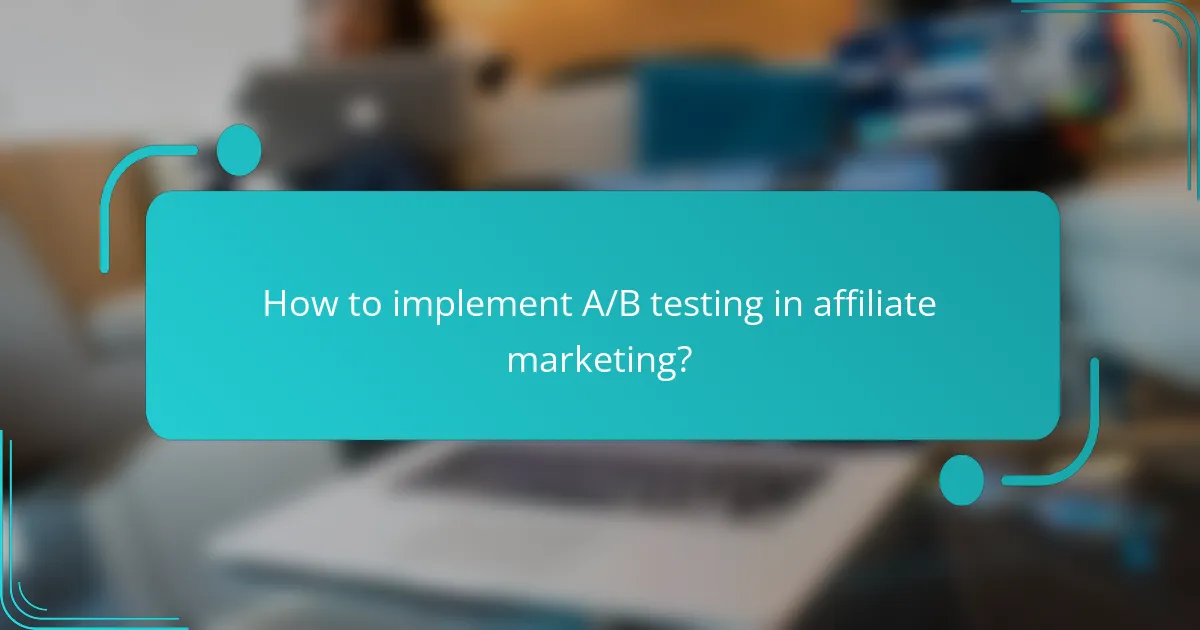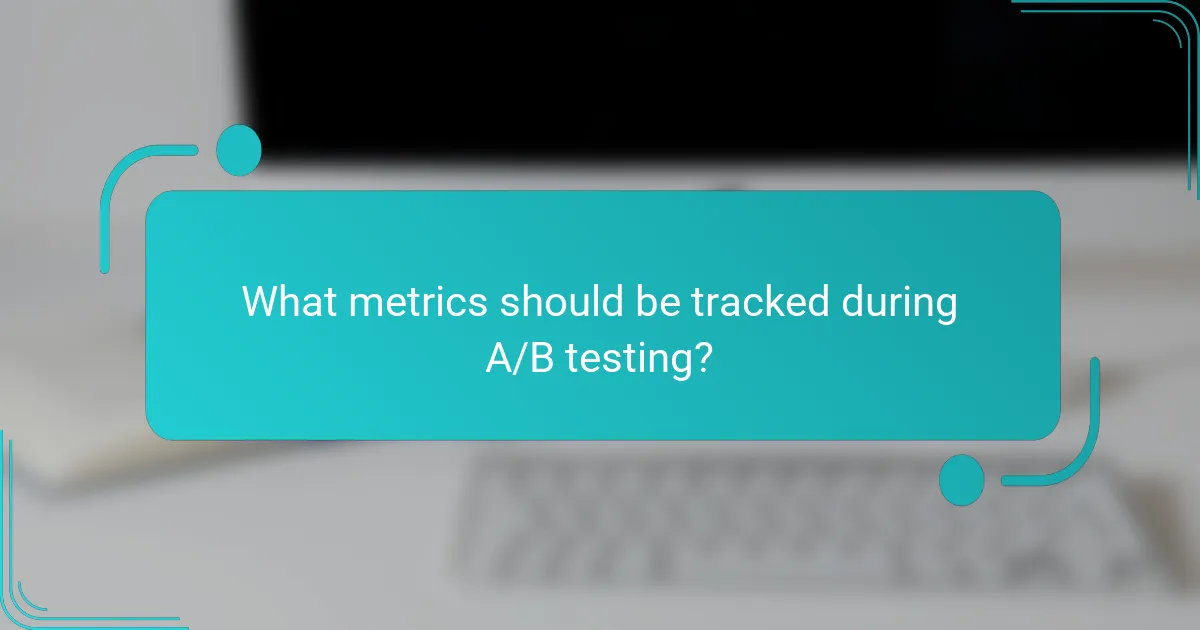Effective A/B testing methods are essential for optimizing affiliate marketing campaigns in the US. By comparing different versions of content or layouts, marketers can make informed, data-driven decisions that enhance conversion rates and overall performance. Utilizing the right tools for A/B testing can significantly improve campaign outcomes and streamline marketing strategies.

What are effective A/B testing methods for US affiliate marketing?
Effective A/B testing methods for US affiliate marketing include various strategies that help marketers optimize their campaigns by comparing different versions of content or layouts. These methods enable marketers to make data-driven decisions that can lead to improved conversion rates and overall performance.
Multivariate testing
Multivariate testing involves testing multiple variables simultaneously to determine which combination performs best. This method allows marketers to assess the impact of different elements, such as headlines, images, and calls to action, on user engagement and conversion rates.
When conducting multivariate tests, ensure that you have sufficient traffic to achieve statistically significant results. It’s often beneficial to start with a smaller number of variations to avoid overwhelming users and complicating analysis.
Split URL testing
Split URL testing, also known as split testing, compares two or more distinct web pages hosted on different URLs. This method is particularly useful for testing major changes in design or layout, as it allows for a clearer analysis of user behavior on each version.
To implement split URL testing effectively, ensure that your tracking tools can accurately measure traffic and conversions for each URL. Consider using this method for significant changes, such as a complete redesign or new sales funnel, to gauge user response accurately.
Sequential testing
Sequential testing involves running tests one after another rather than simultaneously. This approach can be beneficial when traffic is limited, allowing marketers to gather insights from one test before moving on to the next.
While sequential testing can provide clear results, it may take longer to reach conclusions. Be mindful of external factors that could influence results between tests, and ensure that each test is well-defined to maintain clarity in your findings.
Mobile A/B testing
Mobile A/B testing focuses on optimizing content specifically for mobile users, who represent a significant portion of online traffic in the US. This method involves testing different mobile layouts, button sizes, and user flows to enhance the mobile experience.
When conducting mobile A/B tests, prioritize speed and usability, as mobile users often expect quick load times and intuitive navigation. Use analytics tools that can segment mobile traffic to ensure accurate measurement of performance metrics.
Personalization strategies
Personalization strategies in A/B testing involve tailoring content and offers to specific user segments based on behavior, demographics, or preferences. This method can significantly enhance engagement and conversion rates by delivering relevant experiences to users.
To implement effective personalization, utilize data analytics to identify key user segments and test different personalized messages or offers. Monitor performance closely to refine your strategies and ensure that personalization efforts align with overall marketing goals.

How to implement A/B testing in affiliate marketing?
Implementing A/B testing in affiliate marketing involves comparing two versions of a webpage or ad to determine which performs better. This method allows marketers to make data-driven decisions that can enhance conversion rates and optimize marketing strategies.
Define clear objectives
Establishing clear objectives is crucial for effective A/B testing. Determine what you want to achieve, such as increasing click-through rates, boosting sales, or improving user engagement. Having specific goals helps focus your testing efforts and measure success accurately.
For example, if your goal is to increase sales, you might test different call-to-action buttons or promotional offers. Make sure your objectives are measurable and time-bound to assess the impact of your tests effectively.
Choose the right metrics
Selecting appropriate metrics is essential for evaluating the outcomes of your A/B tests. Common metrics include conversion rate, average order value, and bounce rate. Choose metrics that align with your objectives to ensure you are measuring what matters most.
For instance, if you’re testing a landing page, focus on conversion rates and the time spent on the page. This will provide insights into how well the changes resonate with your audience.
Segment your audience
Segmenting your audience allows you to tailor A/B tests to specific groups, enhancing the relevance of your findings. Consider factors such as demographics, behavior, and referral sources when creating segments. This approach can yield more actionable insights.
For example, you might test different ad creatives for new visitors versus returning customers. Understanding how different segments respond can help refine your marketing strategies for better results.
Use A/B testing tools
Utilizing A/B testing tools simplifies the process of creating and analyzing tests. Popular tools such as Google Optimize, Optimizely, and VWO offer user-friendly interfaces and robust analytics. Choose a tool that fits your budget and technical expertise.
These tools typically allow you to run tests without needing extensive coding knowledge and provide detailed reports on performance. Make sure to leverage their features to optimize your A/B testing process effectively.

What are the best tools for A/B testing in the US?
The best tools for A/B testing in the US include platforms that offer robust features, user-friendly interfaces, and integration capabilities with other marketing tools. These tools help marketers optimize their campaigns by comparing different versions of web pages or ads to determine which performs better.
Optimizely
Optimizely is a leading A/B testing platform that allows users to create and run experiments on their websites and mobile apps. It offers a visual editor, making it easy for marketers to set up tests without needing extensive coding knowledge.
With features like multivariate testing and personalization, Optimizely enables businesses to tailor experiences for different audience segments. Consider using it if you need advanced targeting and detailed analytics to drive conversion rates.
Google Optimize
Google Optimize is a free tool that integrates seamlessly with Google Analytics, making it accessible for businesses of all sizes. It allows users to conduct A/B tests, multivariate tests, and redirect tests to enhance user experience.
For those already using Google’s suite of tools, Google Optimize is a practical choice. However, it may lack some advanced features found in paid tools, so evaluate your testing needs before committing.
VWO
VWO (Visual Website Optimizer) provides a comprehensive platform for A/B testing, conversion optimization, and user behavior analysis. Its intuitive interface allows marketers to create tests quickly and analyze results effectively.
VWO also offers additional features like heatmaps and session recordings, which can provide insights into user behavior. This makes it a strong option for businesses looking to understand how users interact with their sites while running tests.
Adobe Target
Adobe Target is part of the Adobe Experience Cloud and offers powerful A/B testing capabilities along with personalization features. It is designed for larger enterprises that require robust testing and targeting options.
With Adobe Target, users can create sophisticated experiments and leverage machine learning for automated personalization. However, it may be more complex and costly than other options, making it suitable for businesses with significant marketing budgets and advanced needs.

What are common mistakes in A/B testing?
Common mistakes in A/B testing can significantly skew results and lead to poor decision-making. Understanding these pitfalls is crucial for effective testing in affiliate marketing.
Insufficient sample size
Using an insufficient sample size can lead to unreliable results in A/B testing. A small group may not accurately represent your target audience, resulting in skewed data that can misguide your marketing strategies.
To ensure reliability, aim for a sample size that is statistically significant. This often means testing with hundreds or thousands of users, depending on your overall traffic and conversion rates.
Testing too many variables
Testing multiple variables at once can complicate the analysis and obscure which changes actually influenced performance. When too many elements are altered, it becomes challenging to pinpoint the cause of any observed changes in user behavior.
Focus on one or two variables at a time to maintain clarity in your results. For example, if you’re testing a new call-to-action button, keep other elements constant to accurately assess its impact.
Ignoring statistical significance
Failing to consider statistical significance can lead to decisions based on random fluctuations rather than actual performance improvements. Without proper analysis, you might mistakenly implement changes that do not yield real benefits.
Utilize statistical tools to determine significance levels, typically aiming for a p-value of less than 0.05. This ensures that your results are not due to chance and that any changes made are backed by solid data.

How to analyze A/B testing results?
Analyzing A/B testing results involves comparing the performance of different versions of your marketing materials to determine which one yields better outcomes. Focus on key metrics such as conversion rates, user engagement, and feedback to draw actionable insights.
Use analytics platforms
Utilizing analytics platforms is crucial for effective A/B testing analysis. Tools like Google Analytics, Adobe Analytics, or specialized A/B testing software can provide detailed insights into user behavior and conversion metrics. These platforms allow you to track performance in real-time and segment data by demographics or traffic sources.
When selecting an analytics platform, ensure it integrates well with your existing marketing tools. This will streamline data collection and reporting, making it easier to interpret results and make informed decisions.
Compare conversion rates
Comparing conversion rates between the A and B versions is a fundamental step in A/B testing analysis. Calculate the conversion rate for each variant by dividing the number of conversions by the total visitors for that version. A significant difference in conversion rates can indicate which version is more effective.
Look for a minimum detectable effect size to determine if the observed differences are statistically significant. Generally, a difference of 5-10% can be considered noteworthy, but this can vary based on your specific goals and traffic volume.
Assess user feedback
User feedback is a valuable component of A/B testing analysis. Collect qualitative data through surveys, interviews, or feedback forms to understand user preferences and experiences with each version. This can provide context to the quantitative data and help explain why one version performed better.
Consider implementing follow-up surveys after users interact with your A/B test. Ask specific questions about their experience, such as ease of use or visual appeal, to gain deeper insights into their decision-making process. This feedback can guide future marketing strategies and improve overall user satisfaction.